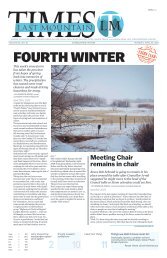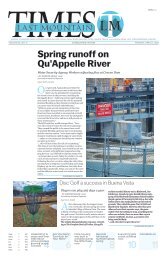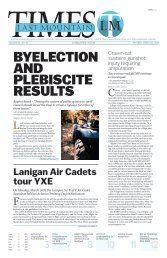LMT July 23 2018
Create successful ePaper yourself
Turn your PDF publications into a flip-book with our unique Google optimized e-Paper software.
Last Mountain Times • Monday, <strong>July</strong> <strong>23</strong>, <strong>2018</strong> • lmtimes.ca<br />
A Lamborghini, a paper airplane, and<br />
a VW Beetle roll Into a wind tunnel...<br />
15<br />
Sounds like the start of the worst joke ever, right? Trust me, it makes sense.<br />
Anyways, I was watching an eighties movie the other day, and a couple of cocaine<br />
dealers stepped out a Lamborghini Countach. The epitome of the eighties, what<br />
the Lamborghini Countach lacked in practically and rear visibility, it more than made<br />
up for in style and stigma. In reality, the Countach is a terrible choice for a drug dealer,<br />
as nothing draws more attention. Why not a Chrysler Magic Wagon, or a little station<br />
wagon? They’re affordable, blend into traffic, and don’t scream out “I’m so expensive<br />
that you have to be doing something illegal to afford me”. Alas, the eighties were all<br />
about drug dealers in exotic cars. That, and aerodynamics. The wedge shape was<br />
strong in the eighties. The third-gen Camaro/Firebird was a wedge, as was the fourthgen<br />
Corvette. The Mustang was a sharp-edged box, but the Dodge Daytona certainly<br />
had that wedge shape to it. It made perfect sense, really, as wedges are aerodynamic,<br />
CAMSHAFT<br />
CORNER<br />
KELLY KIRK<br />
NOKOMIS<br />
and cars that are aerodynamic are fast. The Plymouth Superbird was just a Roadrunner that came to a<br />
point, and it was fast. A piece of paper is just a wobbly mess, but fold it into the correct wedge shape, and it<br />
becomes an airplane capable of flying across a classroom, or into an eyeball. Aerodynamics really caught<br />
on in the eighties, but it wasn’t a new idea, as Tatra was focussing on them half a century earlier.<br />
Who are Tatra? I thought I could tell you, but honestly, I hardly know myself. They’ve been around well<br />
over a century, and they’re still going strong in Czechoslovakia today. They’ve built trucks, military equipment,<br />
civilian automobiles, and some really cool aerodynamic streamliners. Pictured is the 1934 Tatra<br />
77. It may not look like much, but even as early as 1934, they were focussing on aerodynamics as a way to<br />
increase performance. From the front, the 77 resembled a Volkswagen Beetle, before one actually existed<br />
as a basis for comparison. One might say the Beetle in fact resembles the 77... From the rear, the 77 has a<br />
long, flowing fastback design, more like a blimp or a submarine than an car. With a tiny little three litre<br />
engine mounted in the rear, and the liberal usage of magnesium for weight reduction, the 77 had a lot of<br />
the right ingredients for speed. By 1938, the Tatra T77A was equipped with a larger three-point-four litre<br />
engine, and a more aerodynamic body yet, featuring a giant shark fin on the back. The changes seem minor,<br />
but this made for a top speed of over one hundred and fifty kilometres per hour, and I would imagine<br />
some decent fuel economy. Imagine what your daily pickup could do with the four hundred and some odd<br />
horsepower it has, if it weren’t a big heavy brick with the aerodynamics of the garage door that it hardly<br />
fits through.<br />
Have a question or comment for Kelly?<br />
Email it to: inbox@lastmountaintimes.ca and we’ll print Kelly’s response in an upcoming issue<br />
Crop Report<br />
For the Period <strong>July</strong> 10 to 16, <strong>2018</strong><br />
Crops across the province are advancing quickly,<br />
according to Saskatchewan Agriculture’s weekly<br />
Crop Report. Eighty per cent of the fall cereals, 78<br />
per cent of the spring cereals, 76 per cent of the<br />
oilseeds and 78 per cent of the pulse crops are at<br />
their normal stages of development for this time of<br />
year. Crop conditions vary widely based on moisture<br />
levels but the majority of crops range from fair<br />
to excellent in condition.<br />
Many areas of the province have seen another<br />
week of wild weather that brought hail, severe wind<br />
and crop damage; however, it also brought some<br />
much-needed moisture. Rainfall ranged from trace<br />
amounts to 103 mm in the Glaslyn area. The Turtleford<br />
area reported 61 mm of rain, the Broadview<br />
area reported 18 mm, the Shaunavon area 48 mm,<br />
the Lumsden area 10 mm and the Saskatoon area<br />
52 mm. Some areas in the west-central and southwestern<br />
regions are still in need of a significant<br />
rainfall to help crops fill pods and heads.<br />
Despite this week’s weather, livestock producers<br />
have continued with haying and now have 22 per<br />
cent of the hay crop cut and 47<br />
per cent baled or put into silage.<br />
Hay quality is rated as seven per<br />
cent excellent, 65 per cent good,<br />
25 per cent fair and three per<br />
cent poor. Many swaths are smaller than normal<br />
and hay yields are below average overall.<br />
Estimated average dryland hay yields at this time<br />
are one ton per acre for alfalfa and alfalfa/bromegrass;<br />
0.8 ton per acre for other tame hay and 1.5<br />
tons per acre for greenfeed. Estimated average irrigated<br />
hay yields are 2.1 tons per acre for alfalfa; 2.2<br />
tons per acre for alfalfa/bromegrass and 2.7 tons<br />
per acre for greenfeed. Pasture growth is limited<br />
in some areas and a significant rainfall would be<br />
beneficial.<br />
Across the province, topsoil moisture conditions<br />
on cropland are rated as two per cent surplus, 57<br />
per cent adequate, 30 per cent short and 11 per cent<br />
very short. Hay land and pasture topsoil moisture is<br />
rated as two per cent surplus, 45 per cent adequate,<br />
35 per cent short and 18 per cent very short.<br />
Producers have seen crop damage this week from<br />
a variety of sources. High temperatures and strong<br />
winds throughout the province continued to stress<br />
crops. Storms brought localized flooding, hail and<br />
strong wind. There have been some reports of high<br />
numbers of grasshoppers in areas, along with some<br />
disease issues caused by fusarium head blight, root<br />
rots and leaf spot diseases. Due to recent high temperatures,<br />
there has been some damage due to heat<br />
blasting in flowering canola crops.

















